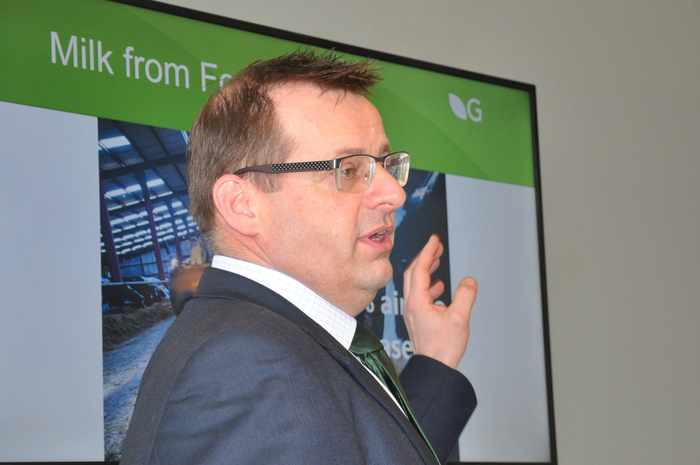Significant increases in grass energy yield/ha – and the improved milk from forage potential resulting – were highlighted in the findings of two new research projects presented at a recent industry briefing.
Work on the value of sward quality and a separate study on multi-cut silage, carried out by Germinal and Volac respectively, were revealed alongside a paper from SRUC professor of dairy nutrition John Newbold, who outlined how maximising milk from forage is positive for bottom line profitability, whatever the production system.
Analysing data from different dairy systems – ranging from an intensive high output system, to a more extensive grazing-based system, and farms in the middle ground – Prof Newbold said across all three farm types, feed was the biggest business cost.
Moreover, in all three cases, the most profitable 25% of farms were the ones that produced more milk from forage – whether grazed grass, silage or a combination. Describing forage as “natural capital”, his advice for profitability was to grow better grass, make better silage and to use the silage better.
Following on from Professor Newbold’s prompt on the importance of growing better grass, Germinal GB’s Ben Wixey referenced a new study now underway at the Germinal Research Station, where the metabolisable energy (ME) yield/ha value of perennial ryegrasses is being compared with the energy potential from weed grasses that predominate in deteriorating swards.
“Grass leys do deteriorate with age, which means lower value weed species replace the perennial ryegrasses that were selected and sown at the time of reseeding,” he said. “Despite this knowledge, it’s a fact that reseeding rates remain stubbornly low, and that all too many swards contain a significant proportion of weed species that will affect productivity.
“At our Melksham facility we are measuring and analysing the common weed grasses alongside modern perennial ryegrasses, so that we are able calculate the impact of declining sward quality and therefore the value of routine reseeding.
“Taking just the second cut silage scenario in our trials, we’ve calculated that a new reseed would potentially contribute around 2,000 litres/ha more milk from forage than a five year old ley with just half of the perennial ryegrass remaining. If we extend the life of the old ley to ten years, with just 25% perennial ryegrass remaining, then the difference rises to 3,410 litres/ha. If we apply a milk price of 27p/litre, this roughly equates to an extra £500 – £1,000/ha in additional milk from forage, simply by maintaining sward quality.
“As our trials programme continues, we’ll be able to look at the impact over a full silage making season and also gain a better understanding of the impact in grazing scenarios too.”
With more dairy farmers now making multi-cut silage – where grass is cut younger and more frequently as a way of improving milk from forage – Volac scientist Dr Mark Leggett said new
farm-based Ecosyl research had examined the potential of multi-cut to deliver extra milk.
Results confirmed that grass from a five-cut system was indeed more nutritious than from a more traditional three-cut approach – with an average digestibility (D value) of 72.7 versus 69.7, and delivering 0.5 MJ/kg more energy. Crude protein content was also almost 3% higher.
Over the season, the multi-cut grass also yielded 0.92 t/ha more dry matter (DM). When combined with its higher energy, this equated to it providing an extra 18,582 MJ/ha, Dr Leggett pointed out.
“Based on 5.3 MJ being required to produce 1 litre of milk, this means this particular multi-cut system had the potential to deliver an extra 3,506 l/ha of milk,” explained Dr Leggett.
“At a milk price of 25 pence/litre, this is equivalent to an extra £877/ha earned, which would still leave you about £333/ha better off after deducting the extra contractor costs.”
But while multi-cut grass has the potential to unlock more milk from forage, this is only half the picture, Dr Leggett stressed. You also need to conserve these extra nutrients within the silage.
“Although multi-cut offers nutritional benefits, it can be more challenging to ensile,” he explained. “Its higher protein can contribute to buffering of the fermentation, while shorter cutting intervals can mean less time for slurry to dissipate, and so increased risk of slurry bacteria being present, which can produce DM losses.
“Indeed, a further stage of our research found that when multi-cut was allowed to ferment without an additive, not only was the fermentation slow, with enterobacteria, the bad bacteria often associated with slurry, continuing to grow, but the average DM loss was nearly 10%. By comparison, average DM loss was virtually halved when treated with Ecosyl additive, and there was clear evidence of better protein preservation.
“It was concluded that multi-cut offers the potential for more milk from forage, but this cannot be realised without careful ensiling, and Ecosyl helped to ‘bank’ its potential,” he added.


